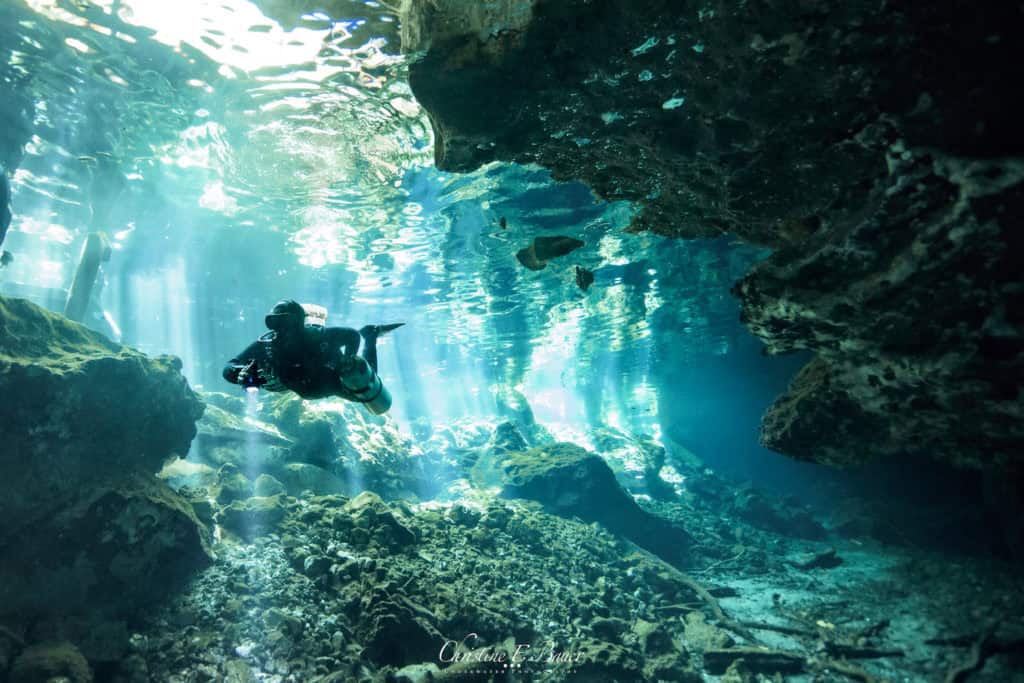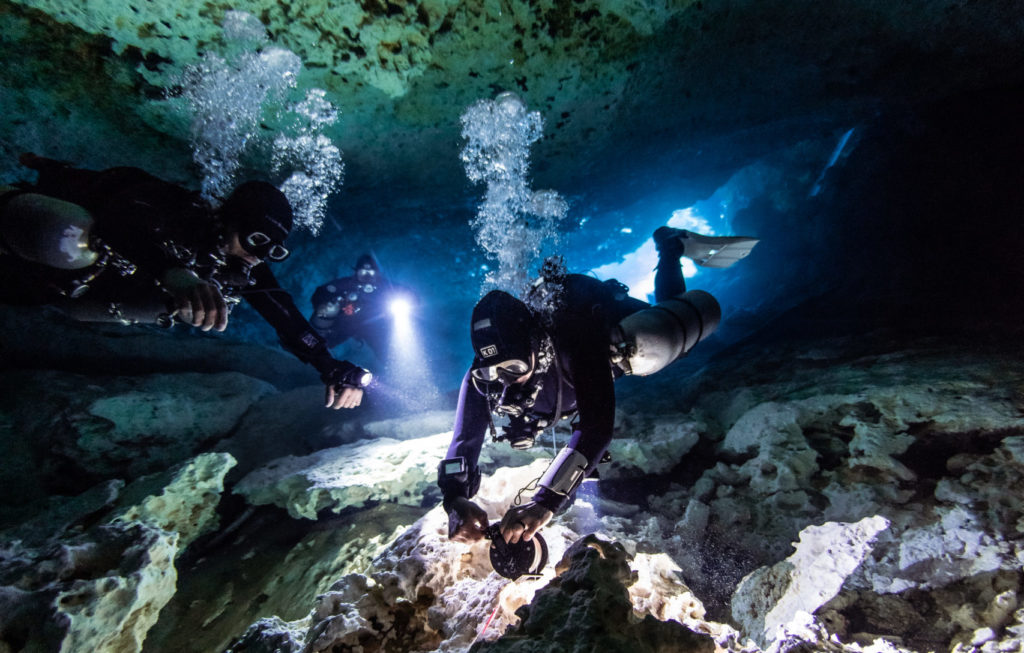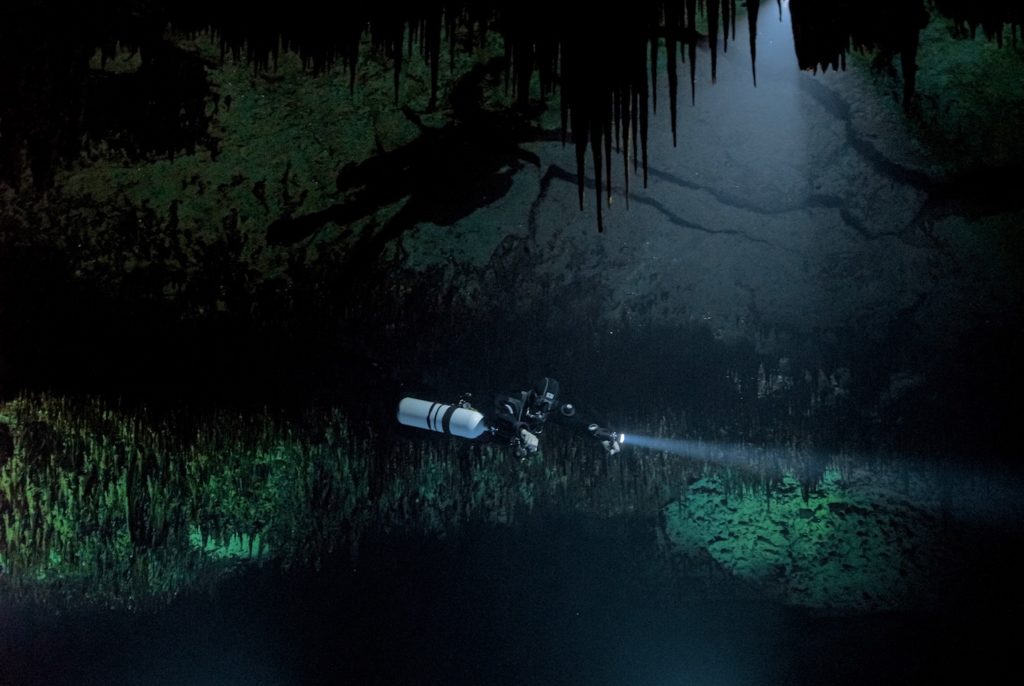With the Yucatan Peninsula’s countless Cenotes, Mexicos Southeast is a top travel destination for cavern and cave divers. The world’s longest underwater cave system is located here and tempts many divers to come to this part of Mexico to enjoy the Cenotes or to complete their cave diving training.
Recreational divers, cavern & technical cave divers, cave exploration thrillseekers, and scientists alike fall in love with the enchanted Cenotes and highly decorated, flooded passages connecting to the huge cave systems found along the coast.
But wait – Cavern vs. cave diving: What’s the difference? In this blog, we will answer that exact question and give you the best tips for both – cenotes, cavern diving & cave diving in Mexico!
What is the Difference Between Cavern and Cave Diving?
Planning their dive trip to the Riviera Maya, mostly recreational divers come up with the following question regularly:
“Is Cenote diving cavern or cave diving, and what’s the difference?
In fact, you can start both, a cavern or a cave dive from most Cenotes. Some Cenotes don’t have a sufficient cavern zone and to dive these you’d need a full cave diver certification. Most Cenotes though only require an open water diver certification, more about that later!
So what IS the difference?

What Is Cavern Diving in Cenotes?
Recreational Cenote diving takes place in the so-called cavern area of the Cenote or connected cave system.
The cavern zone in underwater cave diving is defined as the entry area of a submerged cave, where you still have visible access to direct daylight and are no further than 40 meters from your closest exit in the “overhead environment”.
Apart from that rule, cavern divers can’t follow any dive profiles that would require them to pass navigation points of their guidelines (such as “jumps” or “t’s”), and restrictions that require them to manipulate their sequence, equipment configuration, or that prohibit the passing of two divers next to each other. Cenote diving activities are also limited to a maximum of 4 divers per guide, or less depending on the chosen Cenote dive site and diver experience.
How to Get My Cavern Diving Certification?
Although you don’t have to be cavern diving ceritified to dive some Cenotes in Mexico, obtaining this certification certainly opens the doors to many more Cenote dive sites. When thinking about enrolling in the cavern diving course, you quickly notice the minimum requirements to enroll in the course.
You must be 18 years old (15 with parental consent), possess great buoyancy and propulsion skills, and be at least open water diver certified with proof of a minimum of 25 logged dives.
Even though agency standards theoretically allow a cavern course to be done in recreational single-tank configuration, most cavern and cave diving instructors in Mexico require students to complete their cavern diving certification already in full-cave equipment setup, meaning in either side mount or twin-set configuration. That adds the previous completion of either the side mount diver or tec-diver course (or similar) as a requirement for the cavern diving course in Mexico.
Once you meet all requirements and enroll in your cavern diving course, you’ll have to complete a theoretical part & exam, and a minimum of 4 days of in-water training to complete all exercises and skills with your instructor.

What Is Cave Diving?
Cave diving is anything that is diving beyond cavern limits in a cave. It requires technical diving and specialized cave diving training to obtain the full cave diver certification that allows divers to dive past the cavern zone.
Cave diving includes navigational skills, gas management, emergency protocols, technical dive configuration with adequate redundancy in all aspects (gas, light, computers, exposure protection,…), and all the procedures we learn during a cave diving course & more.
How to Get My Cave Diving Certification?
If you are already cavern diving certified, you will need to continue your education to eventually become a full cave diver.
Intro to Cave Diver Course
After completing the cavern diver course, the next step is to enroll in the “Introduction to Cave Diver” course, which teaches further protocols, navigation basics, and emergency procedures.
This course generally lasts anywhere from 2 to 4 days, depending on your initial comfort and knowledge level, and upon certification ensures students meet all requisites to enroll in the full cave diver course.
If you do not seamlessly continue with the Intro-To-Cave Diver Course after obtaining your cavern diving certificate, we recommend doing one day of cavern-refresher or Cenote diving before starting your continuing training.
Full Cave Diver Course
The next and final course to complete your cave diving certification is the full cave diver course.
This is the challenging final section of your educational career to be a cave diver and holding this certification states you as being an independent and capable diver in overhead environments up to your level of training.
Completing this course opens many opportunities for amazing cave dives, and builds the base for any continuing cave diving education like stage cave diving, DPV, or CCR cave diving.

Cavern Vs. Cave Diving in Mexico
Cave Diving in Mexico
The world’s longest underwater cave systems Sac Aktun and Ox Bel Ha are located along the coast of the Riviera Maya, reaching a staggering length of more than 800 kilometers combined, and connecting hundreds if not thousands of Cenotes. That makes a massive playground for underwater cave diving in Mexico and lures technical cave divers, and those who want to be, from all over the world to visit.
Many local dive operations offer logistical and guiding support for cave divers, so they benefit from professionally trained cave diving guides with knowledge about our local caves, underwater cave systems, common marking procedures, and more.
Cenote & Cavern Diving in Mexico
Good news: you can dive in the Cenotes without a cavern diving certification!
Not only do technical divers come to experience the mindblowing Cenotes, but recreational divers even without cavern diving certification can dive in many of the Cenotes in Mexico.
All you need is an open water diver certification or similar, a checkout dive and you’re ready to go with your Cenote dive guide!
Learn more about our favorite Cenotes for open water divers here!
Dive Training, Cavern and Cave Diving with DivePoint Mexico
Hooked on diving into water-filled holes in the ground? Us too! Join us!
Read about our top 8 Cenotes near Tulum!
Take your diving to the next level and enroll in your cavern or cave diving course in Mexico, join our daily 1-day Cenote diving trips, or sign up for a cave diving day in some of the most beautiful cave sites in the world. In case you’re up to diving for more than 1 day, we can help you create a unique dive package, or you check out our Cenote diving packages.


